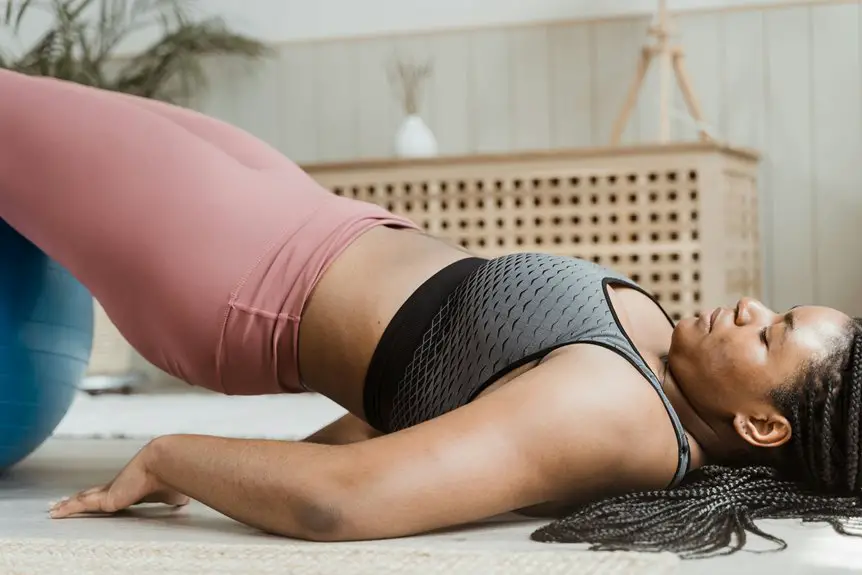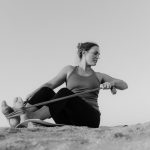To combat tightness in your hips and hamstrings from long hours at a standing desk, try including these key stretches in your routine. Perform the Hip Flexor Stretch by kneeling and pushing your hips forward. The Standing Hamstring Stretch offers relief by lifting one leg while hinging at the hips. Don’t miss the Seated Forward Bend, Pigeon Pose, and Figure Four Stretch to enhance flexibility. These stretches can make a world of difference, and there’s more you can explore.
Table of Contents
Key Takeaways
- Hip Flexor Stretch: Kneel on one knee, push hips forward, and hold for 20-30 seconds to relieve tightness and improve flexibility.
- Standing Hamstring Stretch: Stand tall, shift weight onto one leg, lift the opposite leg, hinge at the hips, and hold for 15-30 seconds.
- Seated Forward Bend: Sit with legs extended, inhale and lift arms, then hinge at hips to reach forward, holding for at least 30 seconds.
- Pigeon Pose: Start in tabletop, bring one knee forward while extending the opposite leg back, and hold for 30 seconds to a minute for hip opening.
- Figure Four Stretch: Perform seated at your desk by crossing one ankle over the opposite knee, gently pressing down to stretch hips and hamstrings.
The Importance of Stretching for Standing Desk Users
As you spend long hours at your standing desk, it’s easy to forget how essential stretching is for maintaining your comfort and mobility.
Standing for extended periods can lead to tightness in your hips and hamstrings, which may cause discomfort and even pain. Incorporating regular stretches into your routine helps counteract this tension, improving your overall posture and flexibility.
You’ll notice increased blood flow, which can boost your energy levels and focus while working. Taking short breaks to stretch not only enhances your physical well-being but also promotes mental clarity.
Hip Flexor Stretch
The hip flexor stretch is a crucial move for anyone looking to relieve tightness and improve flexibility in the hips. This stretch targets the muscles that often become tight from prolonged sitting, especially if you use a standing desk. To perform the stretch, kneel on one knee with the other foot in front, forming a 90-degree angle. Gently push your hips forward while keeping your back straight. Hold for 20-30 seconds and switch sides.
Here’s a quick guide to help you remember:
| Step | Description |
|---|---|
| Position | Kneel on one knee |
| Front Foot | Place the other foot in front |
| Push Hips | Gently push your hips forward |
| Hold | Maintain the stretch for 20-30 seconds |
| Switch | Repeat on the other side |
Standing Hamstring Stretch
The Standing Hamstring Stretch is a simple yet effective way to improve your flexibility and posture.
By using proper stretching techniques, you can maximize the benefits and prevent injury.
Let’s explore how this stretch can help you feel more balanced and aligned in your daily activities.
Proper Stretching Technique
A well-executed standing hamstring stretch can greatly enhance your flexibility and relieve tension in your legs.
Start by standing tall with your feet hip-width apart. Shift your weight onto one leg and lift the opposite leg straight in front of you, keeping it parallel to the ground. Flex your foot and gently hinge at your hips, reaching toward your toes. Maintain a straight back and avoid rounding your spine.
Hold the stretch for 15-30 seconds, breathing deeply to relax your muscles. Switch legs and repeat.
Benefits for Posture
While many people focus on flexibility, the standing hamstring stretch also plays an essential role in improving posture. By incorporating this stretch into your routine, you can alleviate tightness and promote a more balanced alignment.
When your hamstrings are flexible, it can lead to better spinal alignment and reduce the risk of slouching.
Here are some benefits of the standing hamstring stretch for posture:
- Relieves tension in the lower back
- Encourages proper pelvic alignment
- Prevents overcompensation in the hip flexors
- Enhances overall body awareness
- Supports better movement mechanics
Seated Forward Bend
Five deep breaths can transform your experience in the Seated Forward Bend, a powerful stretch targeting the hips and hamstrings.
To start, sit on the floor with your legs extended in front of you. Inhale deeply, lifting your arms overhead. As you exhale, hinge at your hips and reach forward, keeping your spine long. Relax your shoulders and let your hands rest on your shins, ankles, or feet, depending on your flexibility.
Focus on deepening your breath and feeling the stretch in your lower back and hamstrings. Hold this position for at least 30 seconds, breathing steadily.
When you’re ready, slowly rise, feeling the benefits of increased flexibility and relaxation. You’ll notice a significant improvement in your comfort during long hours at your desk.
Pigeon Pose
Pigeon Pose is an excellent stretch that opens up the hips and releases tension in the lower back. This pose targets tight muscles, helping you feel more relaxed and mobile, especially after long hours at your standing desk.
Here’s how to get the most out of it:
To maximize the benefits of Pigeon Pose, focus on your alignment and breathe deeply into the stretch.
- Start in a tabletop position, aligning your wrists under your shoulders and knees under your hips.
- Bring your right knee forward, placing it behind your right wrist.
- Extend your left leg straight back, lowering your hips toward the ground.
- Keep your chest lifted or lower down for a deeper stretch.
- Hold for 30 seconds to a minute, then switch sides.
Incorporating Pigeon Pose into your routine can greatly improve your flexibility and comfort!
Figure Four Stretch
The Figure Four Stretch is a fantastic way to target your hips and hamstrings, providing relief from tightness and improving overall flexibility.
To perform this stretch, sit on the floor with your legs extended. Bend your right knee and place your right ankle over your left knee, creating a figure four shape. Gently press down on your right knee while leaning forward slightly. You should feel a stretch in your right hip and glute.
Hold this position for 20-30 seconds, then switch sides. You can also do this stretch while seated in your chair at your standing desk, making it a convenient option.
Incorporating the Figure Four Stretch into your routine can help alleviate discomfort and enhance your mobility throughout the day.
Frequently Asked Questions
How Often Should I Stretch While Using a Standing Desk?
You should stretch every hour while using a standing desk. Incorporating short breaks helps maintain flexibility and reduces tension. Don’t forget to listen to your body and adjust your routine as needed for ideal comfort.
Can Stretching Improve My Posture at a Standing Desk?
Yes, stretching can greatly improve your posture at a standing desk. It helps alleviate tension, increases flexibility, and reinforces proper alignment. Incorporating regular stretches will keep you comfortable and enhance your overall work experience.
What Are Signs I Need to Stretch More?
If you’re feeling tightness, discomfort, or fatigue in your muscles, it’s a sign you need to stretch more. Listen to your body; regular stretching can enhance flexibility, reduce pain, and improve overall well-being.
Are There Specific Stretches for Beginners?
Stretching’s as essential as oxygen for beginners! You can start with gentle neck rolls, shoulder stretches, and basic hamstring bends. These will ease tension and improve flexibility, making your body feel rejuvenated and ready to move!
Can Stretching Help Reduce Lower Back Pain?
Stretching can definitely help reduce lower back pain. By improving flexibility and relieving tension in your muscles, you’ll find it easier to maintain good posture, which ultimately supports your back and enhances overall comfort.




